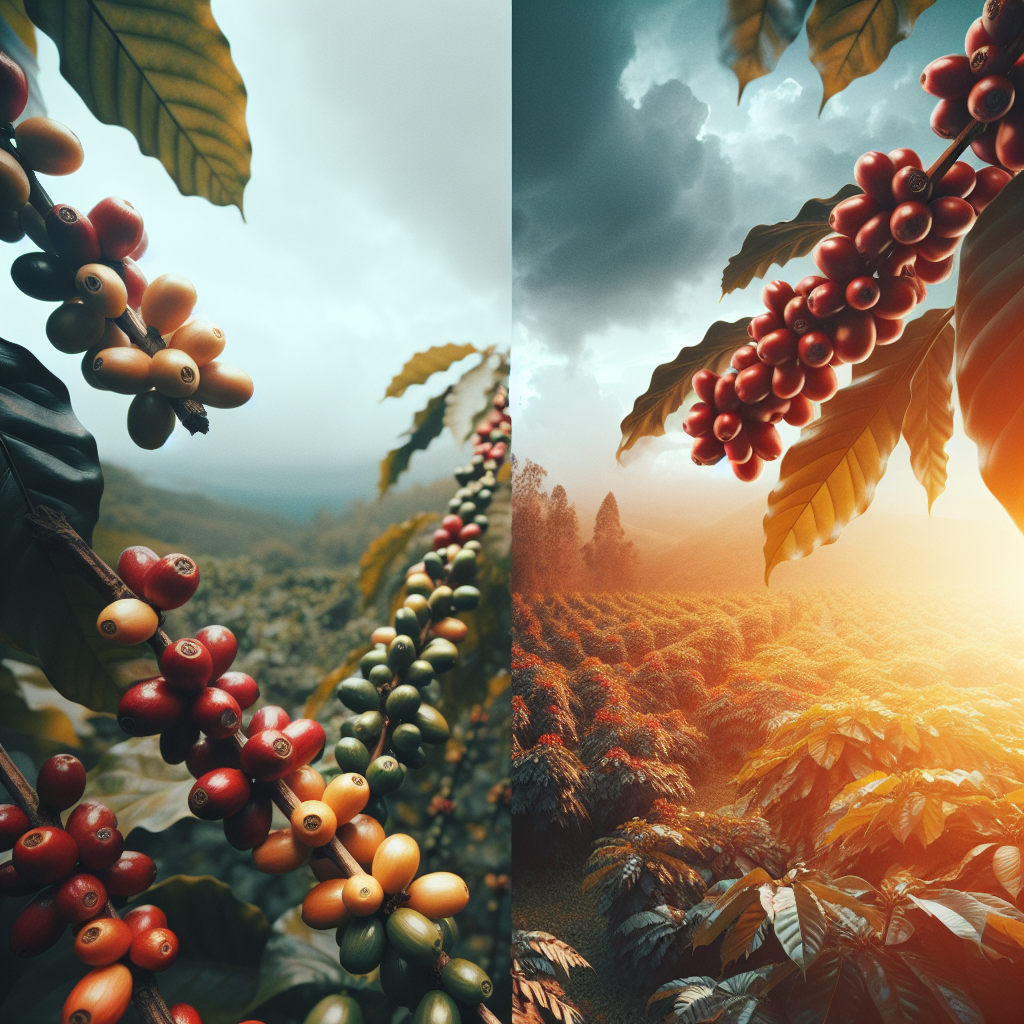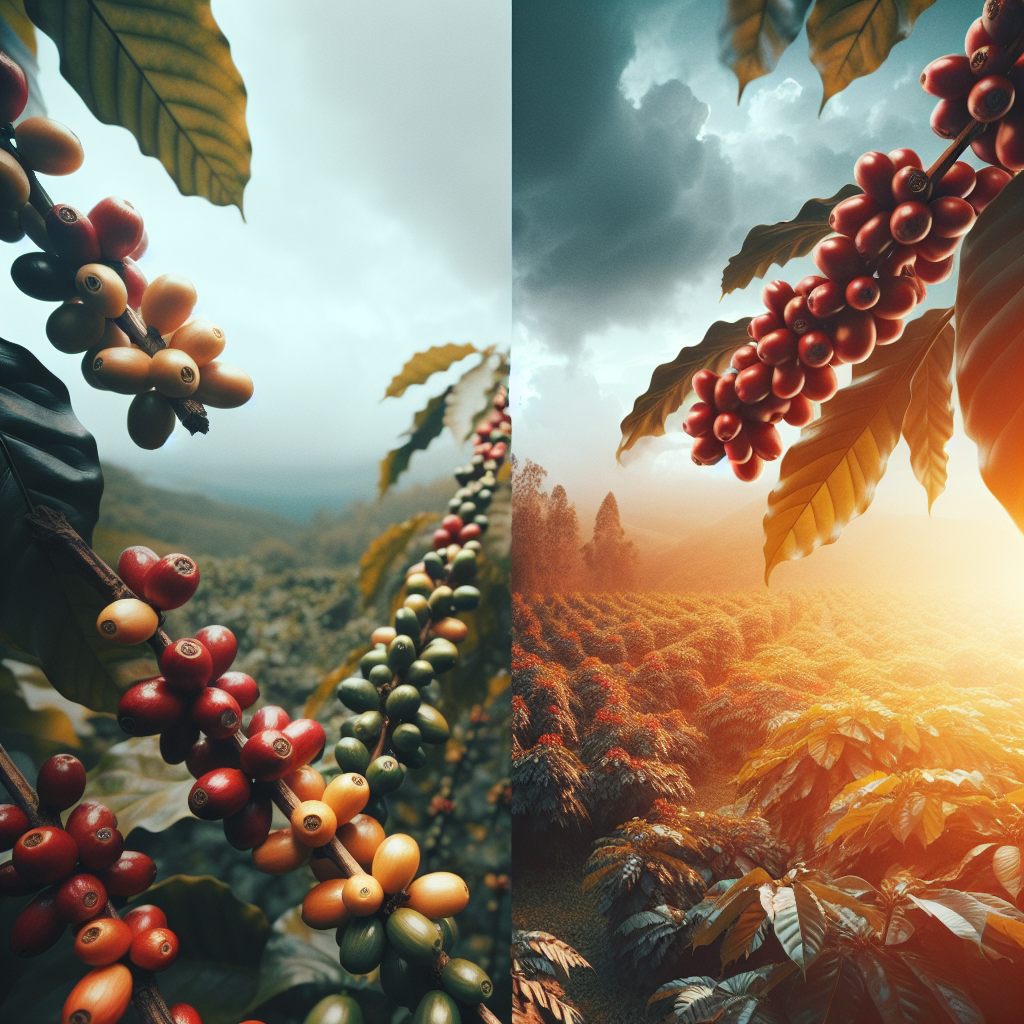Have you ever wondered what sets arabica and robusta espresso beans apart? From flavor profiles to caffeine content, these two types of beans offer distinct characteristics that impact your caffeine fix. Whether you prefer the smooth and nuanced taste of arabica or the bold and robust flavor of robusta, understanding the differences between the two can help you make the perfect choice for your daily cup of espresso. So, let’s explore the unique qualities of arabica and robusta espresso beans and discover which one suits your palate best.
1. Origins
1.1 Arabica
Arabica coffee, scientifically known as Coffea arabica, is believed to have originated in the highlands of Ethiopia. It is the most common and widely grown coffee species, accounting for about 60% of the world’s coffee production. Arabica plants require specific environmental conditions, such as altitudes between 2,000 to 6,000 feet, temperatures between 60-70°F, and well-drained soil. These beans are preferred for their delicate and complex flavors, making them highly sought after by coffee enthusiasts.
1.2 Robusta
Robusta coffee, scientifically known as Coffea canephora, is predominantly grown in lower altitudes and warmer climates, such as Africa, Southeast Asia, and Brazil. It is considered a hardier plant than Arabica, able to thrive in less favorable conditions. Robusta beans are known for their higher caffeine content and more robust flavor profile, often described as stronger and more bitter compared to Arabica. While it is typically considered of lower quality than Arabica, it is still widely used in espresso blends for its unique characteristics.
2. Plant Characteristics
2.1 Arabica
Arabica coffee plants are characterized by their glossy leaves and elliptical shape. They are considered delicate and require meticulous care to ensure optimal growth. Arabica plants have a shallow root system and are susceptible to diseases and pests. This sensitivity to environmental conditions and vulnerability to pests contributes to the higher cost of cultivating Arabica beans.
2.2 Robusta
Robusta coffee plants have larger, more robust leaves and a straighter growth habit compared to Arabica. They develop deeper root systems, making them more adaptable to a wider range of soil conditions. Robusta plants are more resistant to diseases and pests due to their higher caffeine content and greater natural defenses. Their ability to thrive in less ideal conditions makes robusta coffee generally more affordable to cultivate.
3. Flavor Profile
3.1 Arabica
Arabica beans are renowned for their complex flavor profiles, offering a range of delicate, nuanced notes. The flavors of Arabica coffee can vary significantly depending on factors such as the region of cultivation, altitude, and processing methods. Generally, Arabica beans boast a wider range of flavors, including fruity, floral, and sweet notes. The acidity of Arabica coffee tends to be higher but well-balanced, providing a pleasant acidity that enhances the overall flavor experience.
3.2 Robusta
Robusta beans have a more straightforward flavor profile compared to Arabica. They tend to have a stronger taste, often described as earthy, woody, and sometimes even nutty. The bitterness in robusta coffee can be more prominent than in Arabica due to its higher caffeine content. While robusta beans may not have the same complexity of flavors as Arabica, they contribute to the intensity and body of espresso blends.

4. Caffeine Content
4.1 Arabica
Arabica coffee typically contains around 1.0-1.5% caffeine by weight, making it lower in caffeine compared to robusta. This lower caffeine content can make Arabica coffee a preferred choice for those who are more sensitive to the effects of caffeine or prefer a milder coffee experience.
4.2 Robusta
Robusta coffee, on the other hand, has a significantly higher caffeine content, ranging from 2.0-2.7% caffeine by weight. The elevated caffeine levels contribute to the characteristic strong and bold flavor of robusta coffee. This makes it a popular choice for those seeking a more robust taste or for espresso blends that require a higher caffeine kick.
5. Growing Conditions
5.1 Arabica
Arabica coffee plants thrive in specific growing conditions. They favor higher altitudes, where cooler temperatures and well-drained soil prevail. Arabica beans are usually cultivated between 2,000 to 6,000 feet above sea level, in regions that offer the necessary combination of temperature, precipitation, sunlight, and soil quality. The high altitude and cooler climate allow the beans to develop more slowly, resulting in the nuanced flavors that are characteristic of Arabica coffee.
5.2 Robusta
Robusta coffee plants are more adaptable to different growing conditions compared to Arabica. They can tolerate lower altitudes, higher temperatures, and a wider range of soil types. Robusta plants are generally cultivated below 2,000 feet above sea level in regions with warmer climates. The ability to grow in less ideal conditions contributes to robusta’s higher overall production volume and affordability.
6. Cultivation and Harvesting
6.1 Arabica
Cultivating Arabica coffee requires attention to detail and care. The plants are more delicate and susceptible to diseases and pests, making pest control and disease management crucial. Arabica trees take longer to mature and start producing fruit, often requiring several years before the first harvest. Arabica coffee cherries are handpicked when ripe, ensuring only the highest-quality beans are harvested.
6.2 Robusta
Robusta coffee plants are generally easier to cultivate and harvest compared to Arabica. They have a shorter maturation period, typically reaching full productivity within two to three years. Robusta cherries can be harvested by either handpicking or mechanical methods. The lower susceptibility to diseases and pests also simplifies the cultivation process, contributing to its higher overall production volume.
7. Price
7.1 Arabica
Arabica coffee often commands a higher price in the market due to its superior quality and more labor-intensive cultivation requirements. The delicate nature of Arabica plants, longer maturation period, and vulnerability to pests and diseases contribute to higher production costs. The unique flavor profiles and the demand from coffee connoisseurs also contribute to the premium pricing of Arabica beans.
7.2 Robusta
Robusta coffee is generally priced lower than Arabica due to its higher production volume, lower cultivation costs, and less complex flavor profile. The robusta beans’ affordability makes them a preferred choice for use in blended coffees, where the flavor balance and cost considerations come into play.
8. Suitability for Espresso
8.1 Arabica
Arabica beans are considered ideal for espresso due to their complex flavors, well-balanced acidity, and delicate nuances. Espresso made with Arabica beans tends to have a smoother and more refined taste, making it a popular choice for those who appreciate the intricate flavors and a lighter coffee experience. However, Arabica beans may not provide the desired crema, the top layer of foam, that robusta often contributes to espresso.
8.2 Robusta
Robusta beans are frequently used in espresso blends to enhance the body, crema, and caffeine kick. Their higher caffeine content and stronger taste provide a bolder and more robust espresso experience. While the flavor profile may not be as nuanced as Arabica, the presence of robusta in espresso blends adds depth and intensity to the overall flavor profile.
9. Roasting
9.1 Arabica
Arabica coffee beans are often roasted at a lighter level to preserve their delicate flavors and complex aromas. Light to medium roasts is the preferred roasting profile for Arabica, allowing the unique characteristics of each bean to shine through. However, the specific roast level can vary depending on personal preference and the desired flavor profile.
9.2 Robusta
Robusta beans are commonly roasted at a darker level to diminish some of their more overpowering flavors and bitterness. Dark roasting helps to balance the flavors and reduce the earthy and woody notes characteristic of robusta coffee. The darker roast also enhances the body and intensity, making it suitable for blending in espresso preparations.
10. Blending
10.1 Arabica
Arabica beans are often featured in specialty coffee blends due to their intricate flavors and complex profiles. Blending Arabica coffee from different regions can create a harmonious balance of flavors, resulting in a more well-rounded and pleasing cup of coffee. The versatility of Arabica beans allows roasters and baristas to experiment with different combinations to achieve the desired taste profiles.
10.2 Robusta
Robusta beans are commonly used as a component in espresso blends to add body, crema, and an extra caffeine kick. Blending robusta with arabica can create a more balanced and intense espresso experience. The robusta’s stronger flavors and higher caffeine content contribute to the overall complexity and boldness of the blend.
In conclusion, the differences between Arabica and Robusta espresso beans are vast. From their origins to flavor profiles, caffeine content, growing conditions, and cultivation methods, each bean type brings its own unique characteristics to the world of coffee. Whether you prefer the delicate nuances of Arabica or the bold intensity of Robusta, both options offer coffee lovers a wide range of choices to suit their individual preferences. So, go ahead and explore the marvelous world of espresso, and savor the distinct flavors that Arabica and Robusta bring to your cup.

